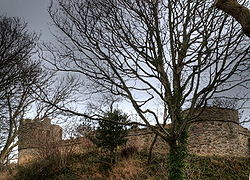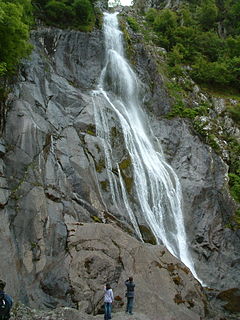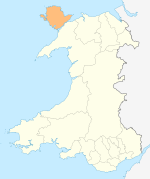
Hugh d'Avranches, also known as Hugh the Fat or Hugh the Wolf, was the second Norman Earl of Chester and one of the great magnates of early Norman England.

The Principality or Kingdom of Gwynedd was a Roman Empire successor state that emerged in sub-Roman Britain in the 5th century during the Anglo-Saxon settlement of Britain.
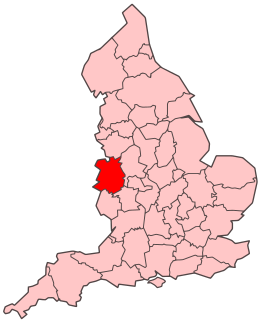
Hugh of Montgomery, 2nd Earl of Shrewsbury, was an Anglo-Norman aristocrat and member of the House of Bellême. He was also known as Hugh the Red.
Llywelyn Bren, or Llywelyn ap Gruffudd ap Rhys or Llywelyn of the Woods (English), was a nobleman who led a revolt in Wales during the reign of King Edward II of England in 1316. The revolt would be the last serious challenge to English rule in Wales until the attempts of Owain Lawgoch to invade Wales with French support in the 1370s. Hugh Despenser the Younger's unlawful execution of Llywelyn Bren helped lead to the eventual overthrow of both Edward II and Hugh.
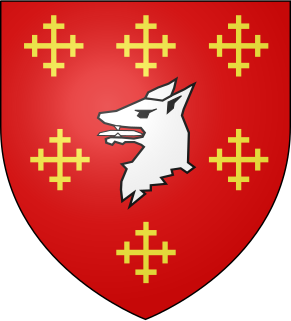
Richard d'Avranches, 2nd Earl of Chester was the son of Hugh d'Avranches, 1st Earl of Chester, and wife Ermentrude of Clermont.
Robert of Rhuddlan was a Norman adventurer who became lord of much of north-east Wales and for a period lord of all North Wales.
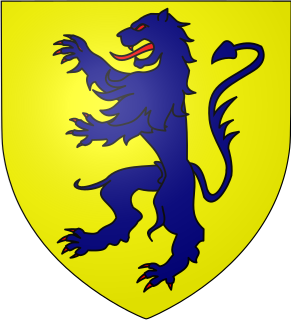
Cadwgan ap Bleddyn (1051–1111) was a prince of the Kingdom of Powys in eastern Wales.

Castell y Bere is a Welsh castle near Llanfihangel-y-pennant in Gwynedd, Wales. Constructed by Llywelyn the Great in the 1220s, the stone castle was intended to maintain his authority over the local people and to defend the south-west part of the princedom of Gwynedd. In 1282 war with Edward I of England resulted in the death of Llywelyn's grandson, Llywelyn ap Gruffudd, and Castell y Bere fell to English forces. Edward I expanded the castle further and established a small town beside it. In 1294 the Welsh leader Madog ap Llywelyn mounted a major revolt and the castle was besieged and apparently burnt. Edward did not repair it and it became ruined. Today it is in the hands of Cadw and operated as a tourist attraction.

Rhuddlan Castle is a castle located in Rhuddlan, Denbighshire, Wales. It was erected by Edward I in 1277, following the First Welsh War.

Twthill is a Norman castle located near the town of Rhuddlan, Denbighshire in Wales; historic names for the site include Toothill and Tot Hill Castle and it is also known as Old Rhuddlan Castle. It is a motte-and-bailey castle and was later replaced by the much larger, stone-built Rhuddlan Castle. The only remaining visible signs of the old castle are the large mound of the motte, and traces of the wall that surrounded the bailey.

The Norman invasion of Wales began shortly after the Norman conquest of England under William the Conqueror, who believed England to be his birthright. Initially (1067–1081), the invasion of Wales was not undertaken with the fervor and purpose of the invasion of England. However, a much stronger Norman invasion began in 1081 and by 1094 most of Wales was under the control of William's eldest son, King William II of England. The Welsh greatly disliked the "gratuitously cruel" Normans and by 1101 had regained control of the greater part of their country under the long reign of King Gruffudd ap Cynan, who had been imprisoned by the Normans for twelve years before his escape. Gruffudd had some indirect help from King Magnus III of Norway who attacked the Normans briefly off the Isle of Anglesey in northwest Wales near Ynys Seiriol, killing Hugh of Montgomery, 2nd Earl of Shrewsbury and leaving the Normans depleted and demoralized. Magnus went on to take the Orkney Islands, the Hebrides, and the Isle of Man, islands north of Wales and west and north of Scotland and England, in 1098.
This article is about the particular significance of the century 1301 - 1400 to Wales and its people.
This article is about the particular significance of the century 1001 - 1100 to Wales and its people.

Mold Castle, on Bailey Hill in the town of Mold, Flintshire, Northeast Wales, is a motte-and-bailey castle erected around 1072, probably by the Norman Robert de Montalt under instructions from Hugh d'Avranches, Earl of Chester. Little remains except the mound on which the motte was built. It stands close to the 15th-century parish church, St Mary's Church near the centre of the town.
Owain ab Edwin of Tegeingl or Owain Fradwr was lord of the cantref of Tegeingl in north-east Wales at the end of the 11th century. He was the son of Edwin of Tegeingl. He sided with the Normans in their failed invasion of North Wales, and in the 1090s attempted to become ruler of Gwynedd.

The Battle of Anglesey Sound was fought in June or July 1098 on the Menai Strait, separating the island of Anglesey from mainland Wales. The battle was fought between Magnus Barefoot, King of Norway, and the Anglo-Norman earls Hugh of Montgomery and Hugh d'Avranches, and took place as part of Magnus Barefoot's expedition into the Irish Sea, which sought to assert Norwegian rule over the Kingdom of the Isles.
